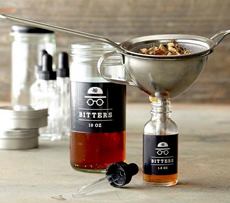GIFT OF THE DAY: Make-Your-Own-Bitters Kit

|
The creative mixologists in your life can perfect their own, homemade bitters recipes for cocktails and mocktails. You can also make coffee and iced coffee more sophisticated with a dash of bitters (check it out). The same materials also enable the production of extracts for cooking and baking. This handsome kit from Hella Bitters contains all the tools and ingredients required, except the alcohol (vodka or other neutral spirit). Just add alcohol and follow the easy, step-by-step instructions. The handcrafted, small-batch bitters will be ready in no time. The kit contains all the equipment needed, plus Hella’s proprietary mixes of herbs, spices, bittering agents and dried fruit peel as a starting point for other blends. Optionally, you can add a good bottle of vodka for $15: New Amsterdam, Pinnacle, Smirnoff Red, Sobieski, UV, etc. Save the Stolichnaya Elit ($60) for sipping on the rocks. |
|
|
WHAT ARE BITTERS? Bitters, which date back to ancient Egypt, are liquids consisting of water, alcohol and botanical extracts.These botanicals—aromatic herbs, barks, flowers, fruits and roots—were known for their medicinal properties. Popular botanicals included cascarilla, cassia, gentian, orange peel, and cinchona bark. The word bitters derives from Old English biter, which evolved thousands of years earlier from the Gothic baitrs, “to bite,” describing the taste of numerous botanicals. The Middle Ages saw an increase in the development of medicines that combined botanicals with alcohol to create tonics, often used to aid digestion (hence the term, digestive bitters, as opposed to the modern “cocktail bitters”). Available “over the counter,” they came to be used as preventive medicines. By the turn of the 19th century, the British practice of adding herbal bitters to wine had become very popular in the U.S. as well. What happened next? By 1806, there are American references to a new preparation, the cocktail, described as a combination of “a stimulating liquor, composed of spirits of any kind, sugar, water, and bitters.” |
||



